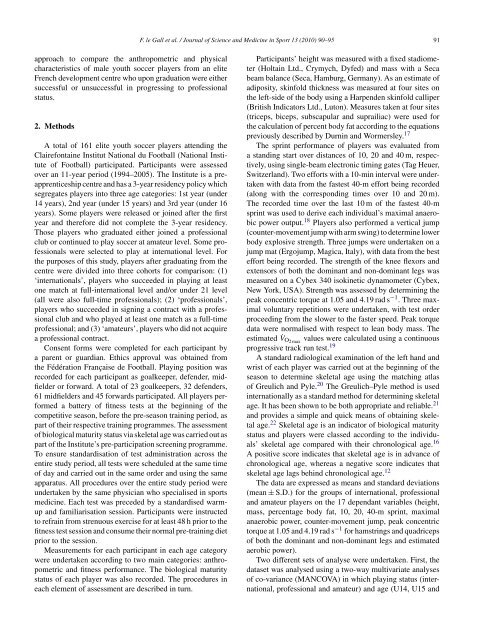ANTHROPOMETRIC
ANTHROPOMETRIC AND FITNESS IN SOCCER
ANTHROPOMETRIC AND FITNESS IN SOCCER
Create successful ePaper yourself
Turn your PDF publications into a flip-book with our unique Google optimized e-Paper software.
approach to compare the anthropometric and physical<br />
characteristics of male youth soccer players from an elite<br />
French development centre who upon graduation were either<br />
successful or unsuccessful in progressing to professional<br />
status.<br />
2. Methods<br />
A total of 161 elite youth soccer players attending the<br />
Clairefontaine Institut National du Football (National Institute<br />
of Football) participated. Participants were assessed<br />
over an 11-year period (1994–2005). The Institute is a preapprenticeship<br />
centre and has a 3-year residency policy which<br />
segregates players into three age categories: 1st year (under<br />
14 years), 2nd year (under 15 years) and 3rd year (under 16<br />
years). Some players were released or joined after the first<br />
year and therefore did not complete the 3-year residency.<br />
Those players who graduated either joined a professional<br />
club or continued to play soccer at amateur level. Some professionals<br />
were selected to play at international level. For<br />
the purposes of this study, players after graduating from the<br />
centre were divided into three cohorts for comparison: (1)<br />
‘internationals’, players who succeeded in playing at least<br />
one match at full-international level and/or under 21 level<br />
(all were also full-time professionals); (2) ‘professionals’,<br />
players who succeeded in signing a contract with a professional<br />
club and who played at least one match as a full-time<br />
professional; and (3) ‘amateurs’, players who did not acquire<br />
a professional contract.<br />
Consent forms were completed for each participant by<br />
a parent or guardian. Ethics approval was obtained from<br />
the Fédération Française de Football. Playing position was<br />
recorded for each participant as goalkeeper, defender, midfielder<br />
or forward. A total of 23 goalkeepers, 32 defenders,<br />
61 midfielders and 45 forwards participated. All players performed<br />
a battery of fitness tests at the beginning of the<br />
competitive season, before the pre-season training period, as<br />
part of their respective training programmes. The assessment<br />
of biological maturity status via skeletal age was carried out as<br />
part of the Institute’s pre-participation screening programme.<br />
To ensure standardisation of test administration across the<br />
entire study period, all tests were scheduled at the same time<br />
of day and carried out in the same order and using the same<br />
apparatus. All procedures over the entire study period were<br />
undertaken by the same physician who specialised in sports<br />
medicine. Each test was preceded by a standardised warmup<br />
and familiarisation session. Participants were instructed<br />
to refrain from strenuous exercise for at least 48 h prior to the<br />
fitness test session and consume their normal pre-training diet<br />
prior to the session.<br />
Measurements for each participant in each age category<br />
were undertaken according to two main categories: anthropometric<br />
and fitness performance. The biological maturity<br />
status of each player was also recorded. The procedures in<br />
each element of assessment are described in turn.<br />
F. le Gall et al. / Journal of Science and Medicine in Sport 13 (2010) 90–95 91<br />
Participants’ height was measured with a fixed stadiometer<br />
(Holtain Ltd., Crymych, Dyfed) and mass with a Seca<br />
beam balance (Seca, Hamburg, Germany). As an estimate of<br />
adiposity, skinfold thickness was measured at four sites on<br />
the left-side of the body using a Harpenden skinfold calliper<br />
(British Indicators Ltd., Luton). Measures taken at four sites<br />
(triceps, biceps, subscapular and suprailiac) were used for<br />
the calculation of percent body fat according to the equations<br />
previously described by Durnin and Wormersley. 17<br />
The sprint performance of players was evaluated from<br />
a standing start over distances of 10, 20 and 40 m, respectively,<br />
using single-beam electronic timing gates (Tag Heuer,<br />
Switzerland). Two efforts with a 10-min interval were undertaken<br />
with data from the fastest 40-m effort being recorded<br />
(along with the corresponding times over 10 and 20 m).<br />
The recorded time over the last 10 m of the fastest 40-m<br />
sprint was used to derive each individual’s maximal anaerobic<br />
power output. 18 Players also performed a vertical jump<br />
(counter-movement jump with arm swing) to determine lower<br />
body explosive strength. Three jumps were undertaken on a<br />
jump mat (Ergojump, Magica, Italy), with data from the best<br />
effort being recorded. The strength of the knee flexors and<br />
extensors of both the dominant and non-dominant legs was<br />
measured on a Cybex 340 isokinetic dynamometer (Cybex,<br />
New York, USA). Strength was assessed by determining the<br />
peak concentric torque at 1.05 and 4.19 rad s −1 . Three maximal<br />
voluntary repetitions were undertaken, with test order<br />
proceeding from the slower to the faster speed. Peak torque<br />
data were normalised with respect to lean body mass. The<br />
estimated ˙VO2 max values were calculated using a continuous<br />
progressive track run test. 19<br />
A standard radiological examination of the left hand and<br />
wrist of each player was carried out at the beginning of the<br />
season to determine skeletal age using the matching atlas<br />
of Greulich and Pyle. 20 The Greulich–Pyle method is used<br />
internationally as a standard method for determining skeletal<br />
age. It has been shown to be both appropriate and reliable. 21<br />
and provides a simple and quick means of obtaining skeletal<br />
age. 22 Skeletal age is an indicator of biological maturity<br />
status and players were classed according to the individuals’<br />
skeletal age compared with their chronological age. 16<br />
A positive score indicates that skeletal age is in advance of<br />
chronological age, whereas a negative score indicates that<br />
skeletal age lags behind chronological age. 12<br />
The data are expressed as means and standard deviations<br />
(mean ± S.D.) for the groups of international, professional<br />
and amateur players on the 17 dependant variables (height,<br />
mass, percentage body fat, 10, 20, 40-m sprint, maximal<br />
anaerobic power, counter-movement jump, peak concentric<br />
torque at 1.05 and 4.19 rad s −1 for hamstrings and quadriceps<br />
of both the dominant and non-dominant legs and estimated<br />
aerobic power).<br />
Two different sets of analyse were undertaken. First, the<br />
dataset was analysed using a two-way multivariate analyses<br />
of co-variance (MANCOVA) in which playing status (international,<br />
professional and amateur) and age (U14, U15 and




